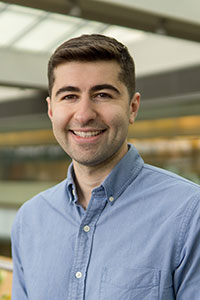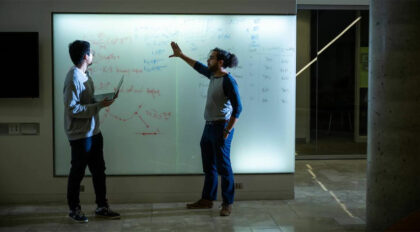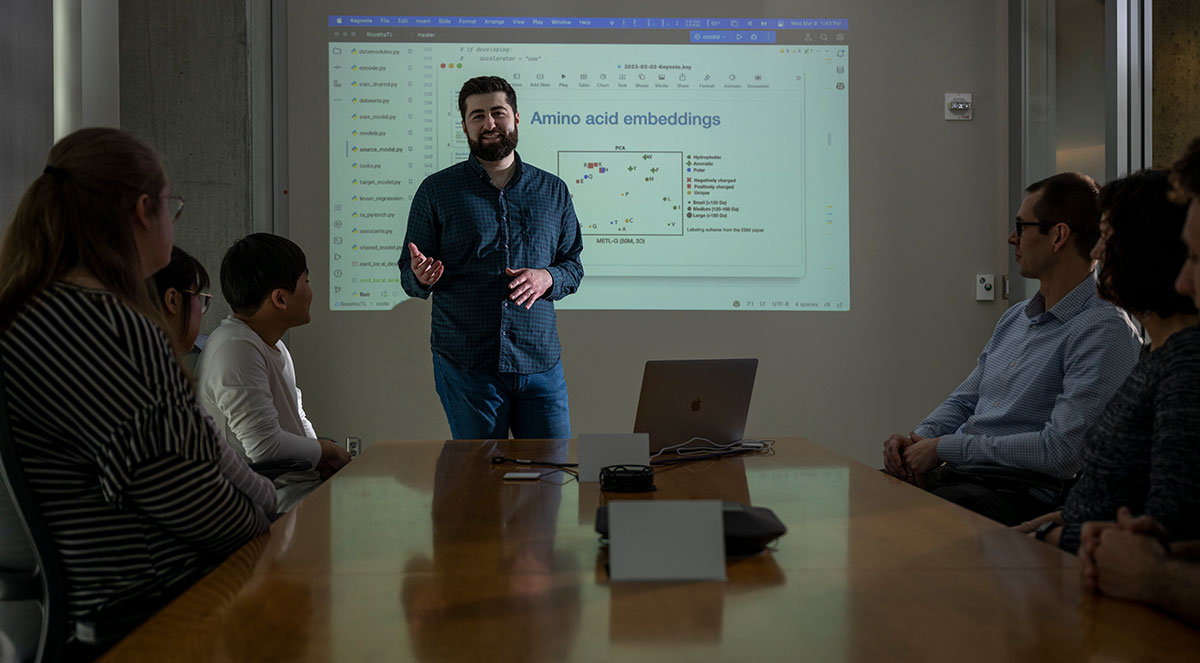Putting machine learning to work in protein engineering
Sam Gelman’s expertise in machine learning could have led him to a variety of lucrative careers developing technologies that shepherd self-driving cars, detect fraud, or automate manufacturing processes.

Instead, Gelman chose to use his computer science skills to apply machine learning – a branch of artificial intelligence that focuses on enabling computers to imitate how humans learn and perform tasks autonomously – to help uncover important biomedical secrets.
“It’s about impact,” says Gelman, a machine learning scientist in Morgridge Investigator Anthony Gitter’s lab. “I want my work to have meaning. For me, that means helping people.”
One of four children of working-class Ukrainian parents who emigrated to the U.S. in the late 1980s, Gelman taught himself to write computer code in middle school and set up a code-sharing website during his high school years in the Baltimore area.
“My parents gave us a lot of freedom to explore,” says Gelman. “That’s what I remember from my childhood – having the freedom to ride my bike all over, to read, and using the internet to look things up.”
Enrolling at George Mason University as a biology undergraduate, Gelman was set on becoming a physician. But a couple of friends were computer science students, so he sampled the field in an introductory course and was hooked.
“I quickly realized that this was my passion,” he says. “But I still had a love of biology. I got involved in a project to study how people walk. We used depth cameras to capture not just an image of a person walking, but depth information like how far away they were from the camera. That’s a whole new dimension of data.”
Gelman took advantage of an internship at the National Institutes of Health, working with three other students in a converted closet with cameras and automation to track the movements of mice around the clock.
Gelman stayed at George Mason and earned a master’s degree while working as a student researcher at the U.S. Naval Research Lab, again studying human gait. Aiming for a doctorate, he was drawn to the University of Wisconsin-Madison, a school known for excellence in computer science and biology.
He worked in Gitter’s lab as a graduate research assistant applying algorithms, data processing pipelines, and machine learning frameworks to advance work in protein engineering. That work continued in the Gitter Lab from 2017-23 as a graduate research assistant while Gelman earned his PhD.
“We’re modifying proteins to have new functions or improved functions with applications in medicine, agriculture, biomanufacturing and other industries,” he says.
Gelman works on the computational side of the research. “There are a lot of ways to engineer proteins, but it’s really hard to know what modifications will give you the desired function. I create machine learning models that can predict, given the protein sequence, what the function will be.”
Gelman and his research team recently had a paper accepted for publication in Nature Methods that focuses on how to use molecular simulations to improve these models. “It’s like the flagship product of my PhD, but it was definitely a team effort,” he says.
“You’re walking through the dark and you don’t always know where you’re going. Your motivation goes through cycles. Sometimes you’re more motivated, and sometimes you’re not. You need to learn about how to overcome those cycles and keep your eyes on the prize.” Sam Gelman
His Morgridge experience is pointing Gelman toward the private sector. He is exploring a potential startup company – tentatively called Mutation37 – with Gitter and Phil Romero, his PhD advisors. Romero, a former UW-Madison biochemistry professor recently took a faculty position at Duke University.
“The concept is based on my PhD research and other work Phil has been doing with robotics. The company would provide a platform for fully autonomous protein engineering using robotics and AI. Our vision is to dramatically accelerate the design of new proteins for applications in biomanufacturing,” Gelman says.
His advice to would-be doctoral students is to be prepared for the ups and downs of discovery and the inevitable frustration during their academic career.
“You’re walking through the dark and you don’t always know where you’re going,” he says. “Your motivation goes through cycles. Sometimes you’re more motivated, and sometimes you’re not. You need to learn about how to overcome those cycles and keep your eyes on the prize.”
Scientific discovery has been complicated by cuts to federal funding for crucial research, limiting the funds needed to power breakthroughs. Against that backdrop, the future of research funding is uncertain. Gelman’s research is driven by grant funding.
“The turbulence is really stressful,” says Gelman who, along with his wife, recently bought a house in Madison. “Seeing how it affects my peers has been pretty hard. This is not just a faceless organization. These are scientists who have passion, who want to help the world. There’s a big human element to it.”
The availability of resources and the culture of Fearless Science are part of what makes Morgridge unique in the scientific world. “We have our principles and we’re going to stick with them. We’re going to keep taking those steps in the dark and trust that we’ll get to discovery,” Gelman says.

Rising Sparks: Early Career Stars
Rising Sparks is a monthly profile series exploring the personal inspirations and professional goals of early-career scientists at the Morgridge Institute.
